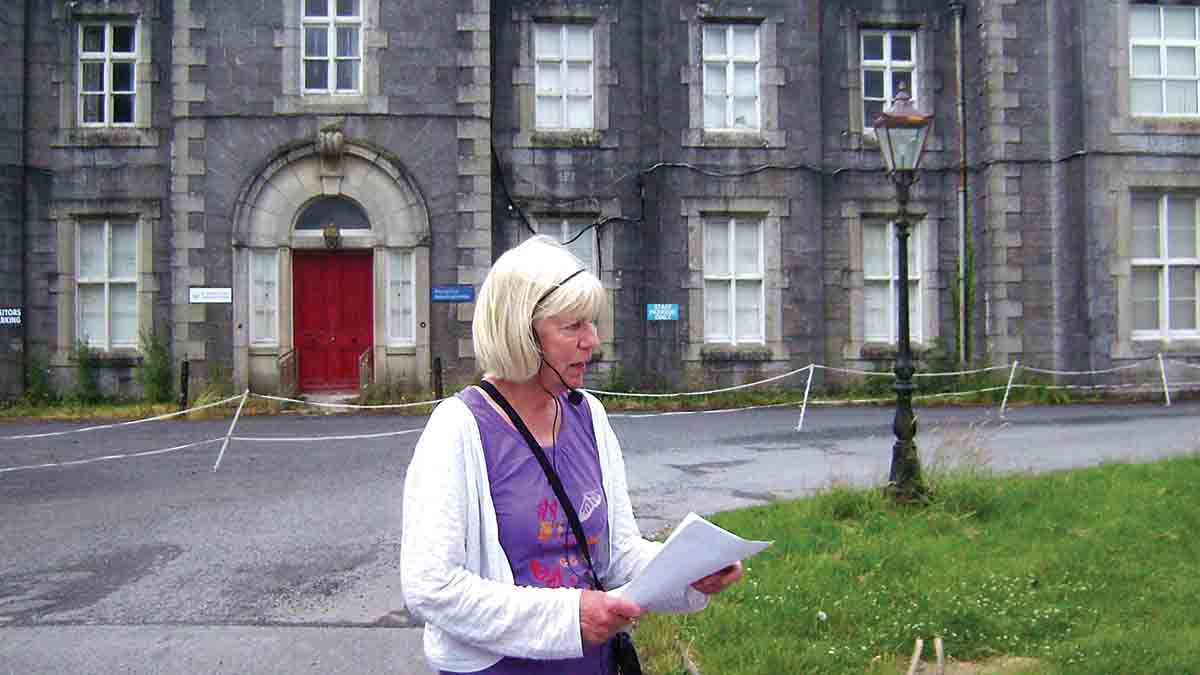BY JOHN FITZGERALD
A shadowy chapter of our past opened up for the Kilkenny Heritage Walkers last weekend when they confronted the mixed legacies of two former industrial schools: St. Joseph’s on the Waterford Road, and St. Patrick’s on the Kells Road.
St Patrick’s first saw the light of day in 1879, when the Bishop of Ossory, Dr Moran, acquired from the State an agricultural college known as the “model farm” to establish an industrial school for boys of the diocese.
Located a mile outside Kilkenny city, the large house with outbuildings stood on 80 acres of land. The Sisters of Charity moved into the house and in December 1879, St. Patrick’s was certified as an industrial school suitable for “the admission of 186 boys up to the age of 10 years.”
From the beginning it was an austere place; plagued by malnourishment that sometimes verged on starvation. The boys learned trades and great emphasis was placed on the acquisition of good manners.
The Kilkenny Journal referred to lively concerts and plays being staged at the school to keep up morale. They certainly needed breaks from the relentless grind of learning through punishment. Thoughts of “sparing the rod” were far from the minds of educators in those days.
A church was provided to cater for the spiritual needs of the boys, and donations poured in from the locality to pay for side altars, sanctuary lamps, statues, and other hallowed accessories.
Whatever about awareness of actual conditions for the boys in the school, the community was deeply attentive to the boy’s prospects in the next world: A bell and belfry of cut stone was donated by pious Kilkenny folk to St. Patrick’s.
The institution closed its doors in November 1966 after which the buildings were converted to a centre caring for people with learning disabilities.
Learning through fear
St. Joseph’s was founded in 1873; a year after the Bishop of Ossory Dr Moran asked the Religious Sisters of Charity to care for homeless girls of the county. The Bishop laid the foundation stone to great acclamation in 1877. The building comprised a convent, school, and chapel.
It went on to cater for girls only until the closure of St Patrick’s School for Boys in 1966 prompted the Department of Education to permit the enrolment of boys in St Joseph’s.
Children came from the Kilkenny area but also from other parts of Ireland, especially Dublin. They found themselves in the school for a variety of reasons, or alleged reasons, the official ones listed as “destitution, illegitimacy, illness or death of a parent, parental inability to exercise proper guardianship or being unable to cope.”
In theory, industrial schools had “no penal or corrective function”, the aim being to ensure that the inmates left with skills to prepare them for life outside the institution. In practice, strict discipline was maintained from the outset and this all too often involved brutal ill-treatment, as revealed in the shocking 2009 Ryan Report.
Records show that the number of children in St. Joseph’s ranged from between 131 in 1933 down to 97 in 1983. Numbers declined during the 1980s and only 25 children remained in 1993. By the time the Health Board took over the institution in 1999 the figure had dropped to ten.
Education at St. Joseph’s, as at St. Patrick’s; went hand-in-hand with a severe punishment regime. Beatings and emotional abuse were common. Fear stalked the rooms and the corridors. Throughout most of its grim history, it was a place to be endured, and you’d be lucky to survive St. Joseph’s unscarred by the longer term effects of cruelty and abuse.
Despite this fearsome reputation, many former inmates expressed gratitude for a basic education received in an age when poverty and illiteracy were rife in Ireland. The technical classes at the school were professionally run.
Acting on a proposal from Lady Cuffe, who took a philanthropic interest in the plight of such children; samples of needlework from the school were sent to the Glasgow Festival, where it impressed patrons and judges. The children of St. Joseph’s also won prizes at story-telling and musical talent events.
In the mid 1940s the quality and value of education at St. Joseph’s received a boost with official recognition from the Education Board: the inmates could now expect to be taught to Primary Cert level.
In defence of St. Joseph’s the point has been made that the nuns there couldn’t cope with the large numbers and had to deal with social and psychological pressures that few human beings would find endurable.
When the South Eastern Health Board took over the building in 1999, the curtain came down on an institution that had impacted the lives of many children…for better or worse.
Dark Heritage
In her presentation on Saturday, Marianne Kelly of the Heritage Walkers avoided passing judgment on either of the institutions, but painted a vivid word picture of what life must have like for the inmates.
Between St. Joseph’s and St. Patrick’s she indicated another historic building: the House of Industry. Now a modern apartment block, it was completed by renowned architect William Robertson in 1833 to serve as a fever hospital. Among its most illustrious patients in the 20th century was the Callan-born, internationally famed artist Tony O’ Malley.
Marianne led the walkers on a sombre tour of St. Patrick’s. It’s like the proverbial “deserted village” nowadays: not a sign of life in any of the buildings that once buzzed with the voices of nuns and teachers, and the laughter or quiet sobbing of boys learning the hard way.
The large visitor group fell into a reverential silence when it entered the little cemetery where the bodies of boys that died while at the school are buried.
The group joined Marianne in a recitation of the “Angel’s Prayer”; in front of a memorial to yesterdays’ children.
The walkers said goodbye to St. Patrick’s and St, Joseph’s, reminders of a sad and almost unbearable part of our heritage.




















